
In my last post, about our mostly all-natural Christmas tree, I mentioned that some of the ornaments are sugared leaves and berries. Sugaring is a really easy, simple way to bring a little bling to natural ornaments, and to invoke snow and frost inside the comfort of our cozy homes.
Sugaring is the green alternative to spray paint and glitter, or heavens forfend, that white foamy stuff that comes in spray cans. After the holidays, this all-natural bling can go straight into the compost pile, or out into some remote corner of the yard to be reabsorbed into nature.
I associate sugaring mostly with cake decorating (think of pretty little sugared violets and borage flowers on wedding cakes), but I remembered it when I wanted to fancy up my ornaments.
It’s super easy. Or more specifically, the basic technique is easy, though I think bakers who capture delicate flowers in a perfectly even coat of shining sugar have the skill down to a fine art. But sugaring sturdy things, like berry clusters or leaves, is simple.
You’ll need:
- One egg white, furiously whipped
- White sugar
- A small paint brush
- Possibly a fine mesh strainer to shake the sugar though, but you can sprinkle sugar with your fingers, too.
- A system for holding the finished product while it dries. Things on sticks or with stems can be propped up in a tray of sand or rice. Flat things can go on racks. Things already hanging from ornament hooks could be dangled from a clothes hanger to dry.
All you do is paint the object with a thin coat of egg white, then sprinkle sugar over it while wet. If the egg white coat is too thick it will A) form snotty looking drips and B) soak up all the sugar after a few minutes. If this happens, you can just add more sugar, but the sugar layer could get kind of chunky looking if this goes on too much. Oh, and I also discovered C) the hard way: a very thick coats of egg white may encourage mold development before it manages to dry. So keep it thin.
Put the ornaments somewhere safe to dry, as mentioned above, and don’t let them touch each other, or they’ll stick. They’ll be dry in a day or so, depending on your weather.
And that is it. If you want more pictures, details and pro-tips, there are really nice instructions over at The Wandering Spoon.

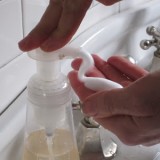

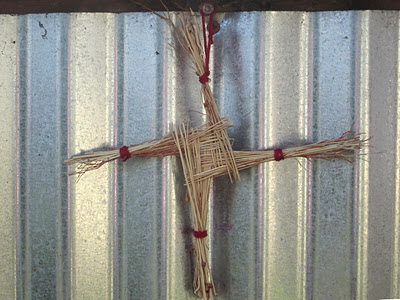
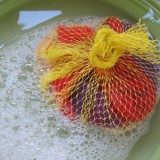
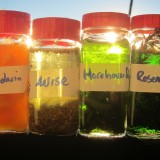
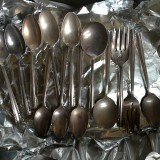
Love the look, and the recyclability, but all I can see is my tree covered in ants having their best Christmas ever, courtesy of my ornaments. Spraying the ornaments with a sealant defeats any enviromental advantage, so that’s out. Thoughts?
Had the same thought as Dede. I was thinking about rock salt or large-flake kosher salt and some Elmer’s glue, thinned with a bit of water.
Mrs Homegrown – you could also do the classic 1st grade craft project of a clove-studded orange!
I also picture ants or other insects thanking me for their Christmas present. Plus, this stuff can leave residue. Don’t your cats like egg whites and sugar? My friend and his wife were young and poor, so the strung popcorn and cranberries. in the middle of the night, halfway through munching, the cat brought down the tree. Six hours after finishing their masterpiece, it was thrown out.
Re: Ants and Cats and Glue
The cats are subjecting the tree to light harassment, but show no interest in the sugared things. Dogs might be a different matter, though. I’d put sugared things out of dog reach.
Ants — I knew there would be ant comments! It’s not an issue for us, because we don’t have ants. I assume the risk is the same for anyone who puts gingerbread or candy canes on their tree.
I have a friend who has to keep up a constant vigilance against ants. I should bring one of my sugared things over to her house and conduct an experiment, see if it’s an attractant. I’m sure she’d appreciate me invoking an ant swarm!
I thought about Elmer’s glue as an alternative to egg white. I’m sure it would work. And it’s not toxic, but it doesn’t strike me as exactly natural, either, so I preferred the straightforwardness of egg white. And this is all about composting. When it comes to composting, I like to think in terms of edibility, and keeping materials as close to nature as possible. All that said, I’m sure a little Elmer’s glue isn’t going to hurt anyone’s compost pile.
I’m not as sure about salt standing in for sugar, because I wonder if it will dehydrate the leaves/berries? But it’s worth experimenting with.
How about borax as sugar and egg white alternative? We tried it with my daughter’s school class last year when they did a Victorian Christmas, but I’m sure I got the idea from the BBC Wartime Farm Christmas programme. I can’t find any reference to it online, but found this: http://twigandtoadstool.blogspot.co.uk/2014/02/borax-bejeweled-bits-of-nature.html
I think this is even more effective- we brushed twigs with borax solution, but leaving them in the solution makes the crystals grow. Whilst looking for the original info I found how to make borax snowflakes from pipecleaners- you could make twig ones? I think we’ll be having a go. I know borax isn’t non-toxic but I’d put it in my compost heap in small quantities.
I was under the impression that borax is a terrestrial plant poison–a salt, basically. Which is why you can’t use borax in the laundry if you’re sending the water to the landscape, but it is fine if it is going to water via the sewer system. Now, of course, dosage is everything in poison, so I assume a bit of it won’t do much harm in compost, but I’m still going to stick with the sugar for composting. But I’ve gotta admit, those borax project look beautiful. Actually, I was curious about trying to crystalize sugar on sticks and stuff–sort of like making rock candy but pulling the objects out before big crystals formed.
I agree, I wouldn’t water my garden with borax (although, perhaps unsurprisingly, companies that sell borax suggest it as a suitable amendment for organic gardening).
As you say, the amount seems to be crucial in the difference between boron deficiency and toxicity so I think I’d still be ok putting the odd decoration in the compost. We have a municipal garden and food waste collection in our area, so I may even put them in there where they’ll be further diluted (somehow I don’t think many other people will be adding borax snowflakes to their brown bins).
Pingback: Big List of Earth-Friendly (homemade, compostable, recyclable, no-plastic) Christmas Decorations | Root Simple
Pingback: Compost-Friendly Holiday Party Decor | 12 Days of Compost (#6) | Gainesville Compost